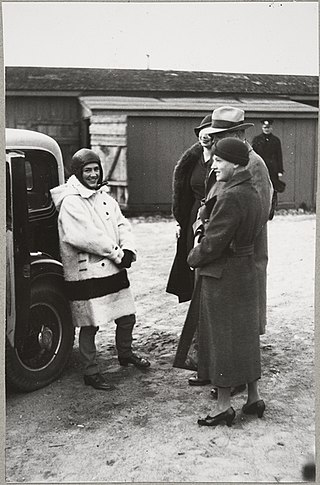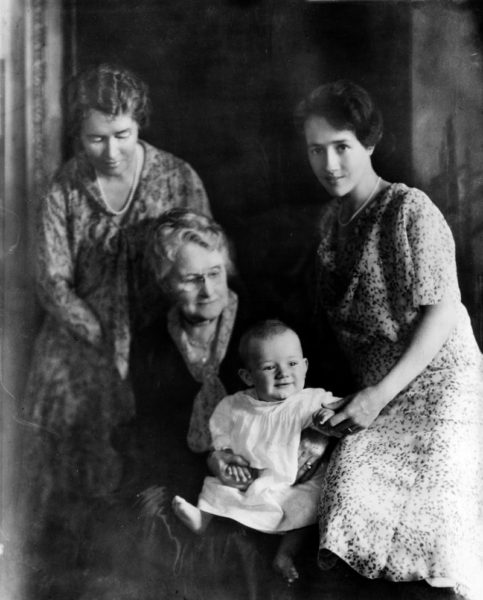 Last updated: August 10, 2023
Last updated: August 10, 2023
American author and pioneering aviator, Anne Spencer Morrow Lindbergh (1906-2001) was born in Englewood, New Jersey. Her father, Dwight Morrow, served in public office as US Ambassador to Mexico and later as a US Senator. Anne’s mother, Elizabeth Reeve Cutter Morrow, was active in promoting education for women and served as acting president at Smith College (her alma mater) in 1939-1940. Anne also attended Smith College, graduating in 1928 with a Bachelor of Arts degree.
During her college years, Anne met aviation pioneer Charles Lindbergh, and they were married at her parents’ home on  May 27, 1929. This instantly pushed her into the spotlight of celebrity status, due to her husband’s 1927 history-making solo transatlantic flight. Anne became a pilot, navigator, and radio operator and was the first American woman to earn a first-class glider pilot’s license. In the early years, the couple flew around the world together and drew intense media attention. They were the first pilots to fly from Africa to South America, and were among pilots who began to fly polar air routes between North America and Asia and Europe.
May 27, 1929. This instantly pushed her into the spotlight of celebrity status, due to her husband’s 1927 history-making solo transatlantic flight. Anne became a pilot, navigator, and radio operator and was the first American woman to earn a first-class glider pilot’s license. In the early years, the couple flew around the world together and drew intense media attention. They were the first pilots to fly from Africa to South America, and were among pilots who began to fly polar air routes between North America and Asia and Europe.
In 1932, the Lindberghs were devastated when their first child, Charles Jr., was kidnapped from their home. There was a huge investigation into the disappearance, and a ransom note was found. Sadly, after roughly 2 months, the baby’s body was discovered in a shallow grave about 4 miles away from the house. The media attention was heightened and electric, especially during the trial and conviction of Bruno Richard Hauptmann, who was executed for the crime.
In 1935, the couple went into exile in Europe for some time, due to the amount of publicity they were receiving – something that Charles called “tremendous public hysteria.” During this time, Anne published her first two books, North to the Orient and Listen! The Wind about her experiences flying with Charles. They returned to the US in April 1939, as World War 2 was ramping up. Anne received a lot of criticism for her 1940 book, The Wave of the Future, that conveyed her support of her husband’s isolationist views, with respect to getting involved in the war. Later in life, she acknowledged that she and Charles had been ”both very blind, especially in the beginning, to the worst evils of the Nazi system.”
 After the war, Anne worked to rebuild their reputations and continued writing for many years. She wrote both poetry and prose and, in 1972, began editing five volumes of her diaries and letters. In this way, she succeeded in having the literary career she sought, while still raising her five children. Charles died in 1974 and in her later years, Anne divided her time between living in her Connecticut home and a chalet in Vevey, Switzerland. She suffered a series of strokes in the early 1990s and was in fragile health. When her oldest daughter passed away in 1993, Anne moved to Vermont to be closer to her other children. She spent the last years of her life close to her daughter Reeve, who cared for her until her death in 2001.
After the war, Anne worked to rebuild their reputations and continued writing for many years. She wrote both poetry and prose and, in 1972, began editing five volumes of her diaries and letters. In this way, she succeeded in having the literary career she sought, while still raising her five children. Charles died in 1974 and in her later years, Anne divided her time between living in her Connecticut home and a chalet in Vevey, Switzerland. She suffered a series of strokes in the early 1990s and was in fragile health. When her oldest daughter passed away in 1993, Anne moved to Vermont to be closer to her other children. She spent the last years of her life close to her daughter Reeve, who cared for her until her death in 2001.
I came to learn about Anne Morrow Lindbergh in my college days, through her book Gift from the Sea. In the book, Anne writes about the struggle of women to achieve serenity and balance in their lives, a topic that still remains relevant today. This thin volume, first published in 1955, was on the nonfiction best-seller list of The New York Times for 80 weeks. In it, Anne describes the importance of getting away from her busy life to chill on the beach. The book captivated me, partly because I used to spend two weeks every summer hanging out on the beach at my grandparent’s condo in Florida, when I was growing up. I used to love sitting out on the balcony in the evenings, watching the  thunderstorms roll in. And walking the beach at low tide and collecting shells along the Gulf of Mexico. And falling asleep to the sound of the surf.
thunderstorms roll in. And walking the beach at low tide and collecting shells along the Gulf of Mexico. And falling asleep to the sound of the surf.
I appreciate the careful, loving way Anne writes about the shells she picked up on the beach and how she compares them with different stages of relationships. In addition, Anne gives us insight into her inner life and that of other women at that time period. In the mid-1950s, women were beginning to look critically at their lives and desires, which eventually led to the second wave of feminist awakening.
Here is the quote from Gift from the Sea that I would like to use in my book and the acrylic monoprint that I made to go with it:
When you love someone, you do not love them all the time, in exactly the same way, from moment to moment. It is an impossibility. It is even a lie to pretend to. And yet this is exactly what most of us demand. We have so little faith in the ebb and flow of life, of love, of relationships. We leap at the flow of the tide and resist in terror its ebb. We are afraid it will never return. We insist on permanency, on duration, on continuity; when the only continuity possible, in life as in love, is in growth, in fluidity – in freedom, in the sense that the dancers are free, barely touching as they pass, but partners in the same pattern.
Anne Morrow Lindbergh (1955)
This book (and this quote, specifically) may have been the first time that I started to become aware of, and to observe directly, the dualisms apparent in this world – ebb and flow, just like the ocean surf. I’m not much of a beach person anymore now, but I still have a place inside where I hold the memories of those experiences of walking along the seashore’s sun-drenched waterline. I pray that we are all able to hold that ebb and flow in mind, so that it might become a natural rhythm written into our lives and relationships.
Reference 1: Morrow Lindbergh, Anne, “Gift from the Sea,” Vintage Books, New York, NY, 1978, p. 108.
Reference 2: Pace, Eric, “Anne Morrow Lindbergh, 94 Dies – Champion of Flight and Women’s Concerns,” New York Times, February 8, 2001.
Reference 3: Woo, Elaine, “Author Anne Morrow Lindbergh Dies,” Chicago Tribune, February 8, 2001.
Photo Credit 1: Charles and Anne Morrow Lindbergh, US Library of Congress Country Studies, http://lcweb2.loc.gov/frd/cs/, public domain.
Photo Credit 2: Photo of pilot Anne Morrow Lindbergh in Helsinki, Katajanokka airport, 1933, CC BY 4.0, Wikimedia Commons, public domain.
Photo Credit 3: Anne Morrow Lindbergh with her mother, grandmother, and son Charles Jr., 1931, digital ID cph.3b19303, Prints and Photographs Division, US Library of Congress, Wikimedia Commons, public domain.















Leave a Reply
Join the conversation by submitting a comment to this blog post below.